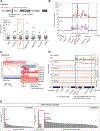Genomic Amplification of CD274 (PD-L1) in Small-Cell Lung Cancer
- PMID: 27620277
- PMCID: PMC6329376
- DOI: 10.1158/1078-0432.CCR-16-1069
Genomic Amplification of CD274 (PD-L1) in Small-Cell Lung Cancer
Abstract
Purpose: Programmed death ligand-1 (PD-L1), encoded by the CD274 gene, is a target for immune checkpoint blockade; however, little is known about genomic CD274 alterations. A subset of small-cell lung cancer (SCLC) exhibits increased copy number of chromosome 9p24, on which CD274 resides; however, most SCLCs show low expression of PD-L1. We therefore examined whether CD274 is a target of recurrent genomic alterations.Experimental Design: We examined somatic copy number alterations in two patient cohorts by quantitative real-time PCR in 72 human SCLC cases (cohort 1) and SNP array analysis in 138 human SCLC cases (cohort 2). Whole-genome sequencing revealed the detailed genomic structure underlying focal amplification. PD-L1 expression in amplified cases from cohorts 1 and 2 was further examined by transcriptome sequencing and immunohistochemical (IHC) staining.Results: By examining somatic copy number alterations in two cohorts of primary human SCLC specimens, we observed 9p24 copy number gains (where CD274 resides) and focal, high-level amplification of CD274 We found evidence for genomic targeting of CD274, suggesting selection during oncogenic transformation. CD274 amplification was caused by genomic rearrangements not affecting the open reading frame, thus leading to massively increased CD274 transcripts and high level expression of PD-L1.Conclusions: A subset (4/210, 1.9%) of human SCLC patient cases exhibits massive expression of PD-L1 caused by focal amplification of CD274 Such tumors may be particularly susceptible to immune checkpoint blockade. Clin Cancer Res; 23(5); 1220-6. ©2016 AACR.
©2016 American Association for Cancer Research.
Conflict of interest statement
Disclosure of Potential Conflicts of Interest
R. Nishikawa reports receiving speakers bureau honoraria from Asteras, Chugai, Eisai, MSD, Nobel Pharma, Novocure, Ohtsuka, and Ohno. M. Peifer is a consultant/advisory board member for NEO New Oncology GmbH. I. Petersen is a consultant/advisory board member for Bristol-Myers Squibb, MSD, and Roche. R.K. Thomas is a consultant/advisory board member for Clovis, Johnson & Johnson, New Oncology AG, and Roche. No potential conflicts of interest were disclosed by the other authors.
Figures


References
-
- Govindan R, Page N, Morgensztern D, Read W, Tierney R, Vlahiotis A, et al. Changing epidemiology of small-cell lung cancer in the United States over the last 30 years: analysis of the surveillance, epidemiologic, and end results database. J Clin Oncol 2006;24:4539–44. - PubMed
-
- William WN Jr, Glisson BS. Novel strategies for the treatment of small-cell lung carcinoma. Nat Rev Clin Oncol 2011;8:611–9. - PubMed
MeSH terms
Substances
Grants and funding
LinkOut - more resources
Full Text Sources
Other Literature Sources
Research Materials

